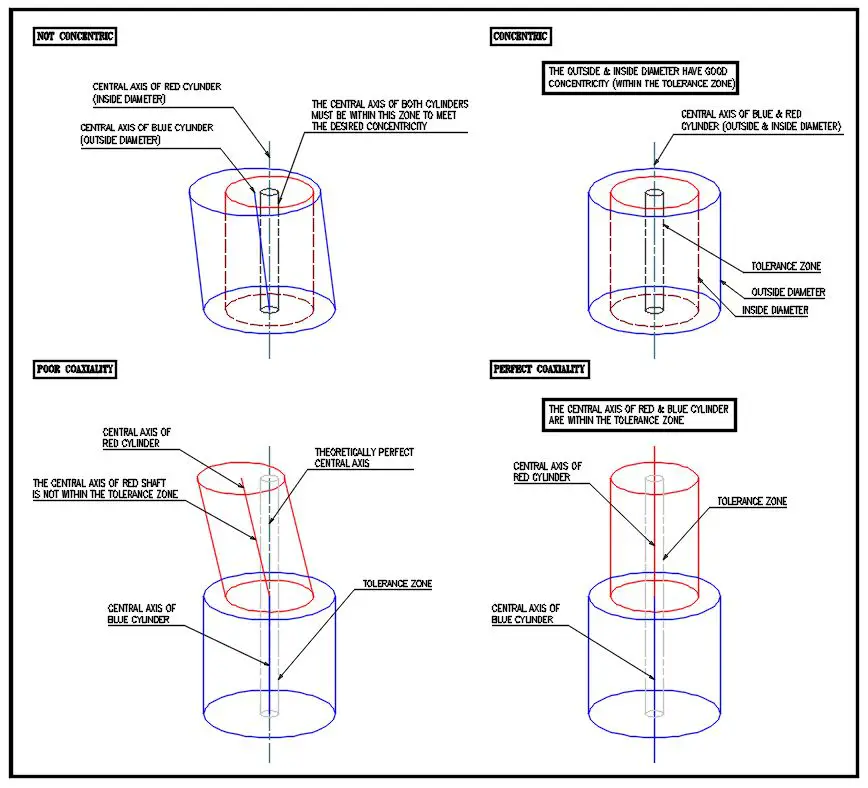When it comes to the axis of a circular or cylindrical object, you will find these two terms “coaxiality” and “concentricity”. If you are an engineer, you denenitely have to know about them. For those who are looking to find how they differ, this post may help you a little bit
Coaxiality
The coaxiality is one of the very complex and advanced type of tolerance which defines a relationship between a feature of size datum axis and a feature of size.
The coaxiality is a measure of the deviation in the central axis of two cylindrical features or in the axis of a geometrical feature and a central or theoretical axis of the whole product. The coaxiality can also be defined as a condition of a controlled cylindrical or circular feature of a product to have its central axis lie in a cylindrical tolerance zone that means that the central axis of this feature is parallel to the datum.
Concentricity
Concentricity is a complex tolerance type used to define the mean points of a cylindrical or spherical part. The basic and most common definition of concentricity is the property of a product that has the same center of all the concerned, inspected and related circles of a specific unit or part. It is a part of Geometric dimensioning and Tolerancing that ensures that one or more circular feature of any part or unit are concentric about a fixed datum axis. Concentricity is normally used for the high-precision parts, and only when there is a critical need to control the mean or median points of that unit.
The true functionality of concentricity is to assure the midpoints of two diametrically opposite points lies within a defined and specific tolerance range. As we are familiar with the circular feature having notched, dips, and many other different surface variations but despite of these the Mass distribution about its central axis should be uniform. Mass distribution plays one of the most important characteristic in applications where the part experiences high-speed rotation because there is a risk of wobbling, vibrations or oscillation which may cause serious damage during the operation performed by that unit.
Due to complexity in measurement, concentricity is advised not to be used frequently and for parts requiring less precision. Alternatively, for most of the applications, this tolerance type can be replaced with either type of runout depending on the application.
Geometric Characteristic Block
Symbolical representation play an important role in order to avoid the errors caused by personal interpretation. The symbol for concentricity consists of two concentric circles is placed in this block to specify this tolerance range as shown below.
Concentricity = ◎
As the coaxiality is not included in the basic tolerance types, it does not have a specific symbol for its interpretation, but it can be applied as combination of different symbols including concentricity. According to ASME standards for GD&T, the coaxiality is controlled by “position” tolerance while according to ISO standards for GD&T, the coaxiality is called out by the concentricity symbol.
Correlation/Similarities Between Coaxiliality and Concentricity
The concentricity and coaxiality can be very similar in some of the applications where both of them can be used interchangeably to achieve the required results. Both of these tolerances can be considered as the “circular” form of a type of GD&T tolerance known as “Symmetry” as both of these tolerances measure how symmetrical a geometrical feature is to a central axis. Also, both of these tolerances require a datum for their complete definition. The tolerance zone of both these tolerances are also similar and is a 3D cylindrical shaped zone.
Differences Between Coaxiliality and Concentricity
Concentricity describes how close the axis of two cylindrical or circular feature are to each other while the coaxiality define how close the axis of a cylindrical or circular feature to a centered on a theoretical axis. The concentricity is one of the basic type of tolerance categorized in the Location group of tolerances while coaxiality is not considered as a basic tolerance type and so it is not categorized in any of the basic tolerance groups. The concentricity is properly defined by a callout symbol but coaxiality does not have a specific callout symbol and is applied as a combination of different general types of tolerances.
Both concentricity and coaxiality are difficult to measure but coaxiality is much more difficult to measure between the two of them. The main reason for coaxiality’s difficulty to measure is that there is no way to know the theoretically centered axis while concentricity has a proper defined way for obtaining the center of a cylindrical feature.
Applications of Concentricity
The proper checking of concentricity is very vital in the manufacturing of ball bearings, Wheel hubs and Brake drums in various manufacturing facilities. They are used for reducing fraction and responsible for reducing the energy consumption. Most common Application where concentricity required are Wheel hub diameters, Machining Pods, and many other items having more than one circular diameter.
Applications of Coaxiality
Due to extreme difficulty and complexity in its measurement, coaxiality is usually applied to the products that required high level of accuracy to function and assemble accurately. The Measurement or inspection of coaxiality is mostly used in manufacturing parts like transmission gears that are required to be coaxial to evade the chances of vibrations and wear and tear. Also, different sections of the drive shafts are require to be coaxial for the proper transmission of torque.
Tools for the Measurement of Coaxiality vs. Concentricity
Both of these tolerances could be measured using modern technologies including CMM, lasers or conventional tools including dial guage, height gauge, etc. Conventionally both Circularity and Cylindricity can be measured using a dial gauge along with a height gauge and for better accuracy CMM is used.

